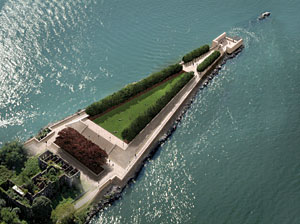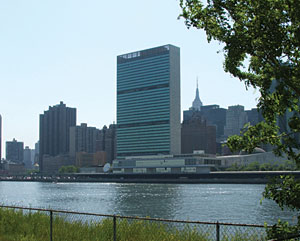It doesn’t take much to envision what Louis I. Kahn’s memorial to Franklin D. Roosevelt will look like if it is eventually finished. It occupies a triangular, 2.8-acre site at the southern tip of Roosevelt Island in New York City’s East River. Construction crews have already shaped the earth into the exact dimensions and contours that Kahn specified in 1973: a raised lawn, to be flanked by two groves of trees and granite steps, that gently slopes down and culminates in an open-air, granite-walled room overlooking the United Nations. These walls will bear quotes from the president’s powerful Four Freedoms speech.

Rendering by Christopher Shelley, photo by Amiaga, courtesy the Franklin and Eleanor Roosevelt Institute

The FDR Memorial will culminate in a granite-walled room that will feature views of the United Nations—an organization the president helped create. The site has already been graded and shaped; it only requires the granite blocks to be laid.
Photo: © James Murdock

Kahn’s 1973 sketch of the memorial.
Rendering: © University of Pennsylvania and the Pennsylvania Historical and Museum Commission / Louis I. Kahn Collection
“Most of the memorial is already there,” says Gina Pollara, executive director of the Franklin D. Roosevelt Memorial—Four Freedoms Park project of the Franklin and Eleanor Roosevelt Institute (FERI). “We only need to plant the trees and lay the granite blocks.”
Easy as that sounds, there is still the challenging matter of finding money to make it happen—something that FERI has struggled with since proposing a memorial in the 1960s. But the project just received a big boost. In June, it earned a letter of support from New York’s new governor, Eliot Spitzer. FERI also received an anonymous $2.5 million donation, helping jump-start fund-raising efforts on a $40 million capital campaign.
These developments are the first in a dozen years. Although Mitchell/Giurgola Architects prepared construction documents following Kahn’s death in 1974, the state and city’s legendary budget crisis sidelined the project. Construction finally began during the 1980s—until money problems, coupled with a change of governors, once again stalled it. Great monuments often take years to complete, but Pollara is now feeling pressure from a competing scheme pegged for the same site.
The Roosevelt Memorial occupies an overgrown area known as Southpoint, which also includes the ruined Smallpox Hospital, designed by James Renwick in 1854. It is the last substantial open space on the island—neé Blackwell’s Island, then Welfare Island—which the state has redeveloped according to Philip Johnson and John Burgee’s 1969 master plan. At the request of then-governor George Pataki, the Trust for Public Land began reenvisioning Southpoint in 2003. It engaged Mark K. Morrison Associates, which, with input from island residents, created a plan titled “Wild Gardens/ Green Rooms.” It calls for stabilizing the Renwick ruins and maintaining Southpoint’s feral quality with pocket-sized forests and lawns. Absent is a Roosevelt memorial.
A team led by WRT Planning & Design is now preparing construction documents for the scheme’s $10 million first phase, which encompasses roughly 8 acres from the Renwick ruins north. Andy Stone, director of the trust’s New York program, expects to break ground by summer 2008. He says that decisions regarding the remaining portion of Southpoint will depend on fund-raising—and the Roosevelt Memorial’s fate.
Although Pollara is energized by her recent successes, this optimism is tempered with pragmatism. Relying purely on state support again would be a mistake, she says. But if FERI is unable to raise a substantial chunk of money from private sources within a year, the memorial will likely remain unbuilt—which Pollara says would be a shame. “Roosevelt Island was renamed because the memorial was going to be put there. Many people today don’t even know who Roosevelt was, but his definitions of freedom are more important than ever.”


Post a comment to this article
Report Abusive Comment